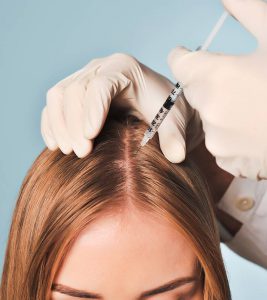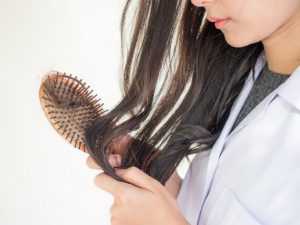Hair Loss Glossary
Aldactone: Brand name for spironolactone, a prescription high blood pressure medication that is also prescribed to treat women’s hair loss.
Alopecia: Loss of hair as a result of illness, functional disorder, or hereditary disposition. The medical term for hair loss.
Recommended Related to Hair Loss
Medications are designed to treat a variety of health conditions, but sometimes they can have unwanted side effects. Certain drugs can contribute to excess hair growth, changes in hair color or texture, or hair loss. Drug-induced hair loss, like any other type of hair loss, can have a real effect on your self-esteem. The good news is that in most cases, it’s easily reversible once you stop taking the drug.
Read the Drug-Induced Hair Loss article > >
Alopecia Totalis: A condition that results in no hair on the scalp. It may begin as Alopecia areata or some other cause.
Alopecia Universalis: A condition that results in no hair on any part of the body; this includes eyelashes, eyebrows, and scalp hair. It may develop as alopecia areata or result from another cause.
Amino Acids: The building blocks of protein. A deficiency of amino acids may adversely affect hair growth.
Anagen: The growing phase of hair, usually lasting between two and six years.
Anagen Effluvium: Loss of hair that is supposed to be in the anagen or growing phase. This is the type of hair loss that is associated with chemotherapy or radiation treatment.
Androgen: general term referring to any male hormone. The major androgen is testosterone.
Androgenetic Alopecia: Hair loss resulting from a genetic predisposition to effects of dihydrotestosterone (DHT) on the hair follicles. Also termed female pattern baldness and male pattern baldness, hereditary alopecia, and common baldness.
Anterior: Front
Antiandrogen: An agent that blocks the action of androgens by preventing their attachment to receptor cells, interfering with their metabolism, or decreasing their production in the body.
Aromatase: An enzyme (actually an enzyme complex) involved in the production of estrogen that acts by catalyzing the conversion of testosterone (an androgen) to estradiol (an estrogen). Aromatase is located in estrogen-producing cells in the adrenal glands, ovaries, placenta, testicles, adipose (fat) tissue, and brain.
Autograft: A graft taken from your own body. Azelaic Acid: Azelaic acid (like Retin-A) is more commonly used in the treatment of acne and other skin conditions. It inhibits the activity of the enzyme 5 alpha-reductase, involved in the conversion of testosterone to DHT.
Biopsy: Piece of tissue cut out for microscopic examination
Bonding: A term used to describe the simple act of gluing a hairpiece onto the scalp.
Catagen: The intermittent stage between the growing (anagen) and resting (telogen) phases of the hair’s growth cycle.
Chemotherapy: Chemical treatment, usually of cancers, using drugs that have high levels of toxicity, frequently causing temporary alopecia.
Club Hair: A hair that has stopped growing or is no longer in the anagen phase. It is anchored to the skin with its “club-like” root, but will eventually be pushed out and replaced by a growing hair.
Cobblestoning: “Plugs” that have not healed flush with the skin and therefore have left the scalp lumpy. “Plugs” seldom heal flush with the skin. Cobblestoning occurs in almost all “plug” procedures.
Cortex: The layer of the hair shaft that surrounds the medulla and is filled with keratin fibers. The main structural part of the hair fiber that accounts for most of its size and strength.
Crown: The highest part of the head.
Cuticle: The outer surface of hair, composed of overlapping scales made of colorless keratin protein. It gives hair luster and shine and also provides some of its strength.
Dermal Papilla: The dermal papilla is situated at the base of the hair follicle. The dermal papilla contains nerves and blood vessels, which supply glucose for energy and amino acids to make keratin. This structure is extremely important in the regulation of hair growth since it has receptors for both androgens and hair-promoting agents.
Dermis: One of the two layers of cells that form skin. Specifically, it is the innermost layer.
Diazoxide: A drug that dilates blood vessels by opening potassium channels and also promotes hair growth.
Dihydrotestosterone (DHT): Male hormone thought to be the main cause for the miniaturization of the hair follicle and for hair loss. DHT is formed when the male hormone testosterone interacts with the enzyme 5-alpha reductase.
Donor Site: Area where pieces of hair-bearing skin are taken from during a hair transplant.
Double Blind Study: A scientific study where neither the subjects nor the researchers know who specifically is receiving the drug of treatment under study.
Dutasteride: A 5-alpha-reductase inhibitor medication by GlaxoSmithKline. Dutasteride inhibits both type-I and type-II 5-alpha reductase.
Epidermis: The outer protective, nonvascular layer of the skin
Estrogen: The female hormone secreted primarily by the ovaries.
Female Pattern Baldness (FPB): Progressive thinning of hair throughout the entire head caused by genes, age, and hormones. It usually develops at a much slower rate than male pattern baldness.
5-Alpha-Reductase: The chemical that is responsible for transforming testosterone into dihydrotestosterone.
5-Alpha-Reductase Inhibitors: Prevent the body from converting testosterone to dihydrotestosterone by blocking the action of the enzyme 5-alpha reductase.
Finasteride: The generic name of the brand name drug Proscar. Proscar is manufactured by Merck and is FDA approved for the treatment of benign prostate enlargement. 1mg tablets of finasteride have been marketed under the brand name Propecia as a treatment for hair loss. It is an antiandrogen that blocks the formation of dihydrotestosterone by inhibiting the enzyme 5-alpha reductase.
Flap: A type of hair replacement surgery in which a piece of hair-bearing scalp is cut on three or four sides and transplanted onto bald areas of the scalp. Follicle: A saclike structure just below the surface of your scalp. It is the sheath within which hair grows.
Follicular Unit: Natural groupings of hair that grow together as a group in the scalp and share the same blood supply.
Follicular Unit Extraction (FUE): Modification of the standard follicular unit transplant where follicular units are removed individually from the donor area.
Follicular Unit Transplantation: An advanced form of hair transplantation in which the surgeon harvests hair in naturally occurring follicular units and grafts them to balding sections of the scalp.
Free Flap: A surgical procedure in which a wide strip of scalp from the side/back of the head is excised and then transferred to the frontal area of the scalp to form a hairline.
Frontal Alopecia: Hair loss at the front of the head.
Gene Therapy: A treatment method that involves the manipulation of an individual’s genetic makeup. It attempts to fix the defective gene which is causing the disease.
Genetic: Pertaining to genes or any of their effects. A gene is the smallest physical piece of heredity. It determines what features we will pass on to our children as well as which ones we have gained from our biological parents.
Grafting: A variety of procedures describing the removal of hair-bearing scalp from the back of the head to a recipient site. The most widely used types of grafting are slit grafts, micrografting, and minigrafting (all outdated). Grafts: Transplanted hair.
Gynecomastia: Excessive development of the male breasts.
Hair Lift: Surgical procedure used to eliminate large areas of bald scalp by lifting and advancing the entire hair-bearing scalp in an upward and forward direction.
Hair Cloning: Currently not available, but cloning hair may make it possible for you to have an unlimited crop of donor hair for a hair transplant.
Hair Integration: See hair weaving.
Hair Intensification: See hair weaving.
Hair Matrix: Region where hair and the structures that compose it (cortex, cuticle, and medulla) are made.
Hair Multiplication: Currently not available; same theory as hair cloning. Individual hair strands will be multiplied or duplicated to create more available donor area for transplantation.
Hair Shaft: Filament (hair) projecting from the epidermis that provides protection and warmth.
Hair Weaving: A process by which a hairpiece (synthetic or human hair) is attached to existing hair on scalp through braiding or another interweaving process.
Hamilton Scale: Method used to rate hair loss. See also Norwood Scale.
Hirsutism: Excessive growth of hair of normal or abnormal distribution.
Hormonal: Pertaining to hormones. Hormones are chemical messengers that are usually carried by the bloodstream. They exert their effects on specific target organs.
Hypertrichosis: Excessive growth of hair all over the body.
Hypothyroid: Deficiency of thyroid hormone normally made by the thyroid gland, located at the front of the neck. Hypothyroidism can result in hair loss.
Inflammatory: Pertaining to inflammation. Inflammation is the process whereby the body reacts to injury or abnormal stimulants.
Infundibulum: The superior, or highest portion, of the hair follicle.
Intermediate Hairs: Hairs that are in a growth stage between vellus (baby or immature) hair, such as on your face, and mature hair stage of growth such as the hair on the scalp.
Isthmus: The middle region of the hair follicle which usually contains the sebaceous gland.
Juri Flap: Surgical procedure that takes a large section of hair-bearing scalp from the side of the scalp and rotates it 180 degrees to the front, forming a hairline.
Keratin: A tough, fibrous, insoluble protein forming hair and finger nails.
Ketoconazole: An antifungal agent that has anti-androgenetic properties. Active ingredient in the shampoo Nizoral.
Lanugo Hair: The downy hair on the body of the fetus and newborn baby. Resembles vellus hair, soft and unpigmented.
Linear Graft: A row of hair and skin that is transplanted onto bald regions (outdated procedure).
Male Pattern Baldness (MPB): The most common type of hair loss; caused by hormones, genes, and age, it is usually progressive in nature. It affects the central and frontal area of the scalp and often results in a pronounced U-shape configuration.
Medulla: A central zone of cells present only in large, thick hairs.
Melanin: Pigmenting granules within the keratin fibers of the hair shaft that determine hair color. They usually decrease with age, resulting in gray or white hair.
Melanocyte: A specialized cell containing pigment (melanin), which determines hair color.
Menopause: The permanent cessation of menstruation and estrogen secretion from a woman’s ovaries.
Micrograft: A very small hair graft consisting of one or two hairs.
Midline: Region toward the middle of the scalp.
Miniaturization: The destructive process by which dihydrotestosterone (DHT) shrinks hair follicles; a key marker of androgenetic alopecia.
Minigraft: A small hair graft consisting of three to eight follicles each.
Minoxidil: A prescription medication taken orally for the treatment of high blood pressure and used topically to retard hair loss and/or encourage hair growth. Generic name for Rogaine.
Nonscarring Alopecia: A broad category of different types of hair loss, including androgenetic alopecia. The hair follicle remains intact, thus increasing the likelihood that hair loss can be reversed.
Norwood Scale: A scale for the classification of hair loss.
Papilla: The small root area at the base of hair, which receives the nutrients needed for hair growth.
Placebo: A pill, topical cream, or injection made to appear exactly like a test medication, but without any of its active ingredients.
Polysorbate 80: An emulsifying agent that has been marketed extensively by “private” companies as a hair growth promoting agent.
Postauricular Flap: Surgical procedure that takes hair-bearing scalp from the area behind the ear and rotates it 90 degrees to the front, forming a hairline.
Posterior Scalp: Back of the head.
Preauricular Flap: Surgical procedure that takes hair-bearing scalp from the temple area and rotates it about 90 degrees to the front, forming a hairline.
Progesterone: Female sex hormone that induces secretory changes in the lining of the uterus essential for successful implantation of a fertilized egg. Synthetic compounds with progesterone-like activity have been developed that, often along with estrogen, are used in oral contraceptives.
Propecia: The brand name for 1mg dose of finasteride, approved for the prevention and treatment of male pattern baldness.
Prosthetic: An artificial replacement.
Punch Graft: A group of ten to twenty hairs in a circular graft.
Recipient Site: Bald area where hair grafts are transplanted.
Rejection: Tissue not accepted by the body and which, therefore, dies.
Retin-A: A brand name for a prescription acne medication. Has in some cases shown to be effective against hair loss, particularly when combined with minoxidil. It can cause extreme scalp irritation that can make hair loss worse.
Retroauricular Area: Area behind the ear.
Rogaine: The brand name for minoxidil topical hair growth solution, available over the counter in 2% solution and in a 5% extra strength solution.
Rotational Flap: A surgical procedure that lifts a three-sided area of hair-bearing scalp and pivots it 90 to 180 degrees into the balding area.
Scalp Reduction: Surgical procedure in which an ellipse of bald scalp is removed from a small midline bald spot and the hair-bearing scalp between the ears is pulled together and sutured closed. This reduces the bald area.
Scarring Alopecia: Patchy hair loss with obvious sign of scalp inflammation.
Scleroderma: A disease of the skin and connective tissue that can cause hair loss over the affected areas.
Sebaceous Glands: Fatty glands found in hair follicles throughout the body that secrete an oil into the hair and surrounding skin.
Seborrheic Dermatitis: A condition marked by oily, scaly patches or spots on the skin. It frequently occurs on the face and scalp.
Sebum: An oily secretion manufactured by tiny sebaceous glands near the follicles that keeps hair lubricated and shiny.
Senescent Alopecia: The type of hair loss that naturally occurs with age, when both the duration of hair growth and the diameter of the hair follicle decrease.
Shock Fallout: The condition that occurs when hair transplantation is performed on men with a significant amount of naturally occurring hair left on their head. Trauma due to the procedure itself induces a telogen phase for much of the hair around the implanted grafts. Hair lost due to shock fallout returns in some cases.
Slit Graft: A graft of three to four hairs inserted into a slit rather than a round hole.
SOD: Also known as Superoxide Dismutase, enzymes that destroy superoxide free radicals and prevent the cellular damage that free radicals cause. Researchers have discovered that SODases also stimulate hair growth and decrease hair loss.
Sprionolactone: A diuretic drug that acts as an antiandrogen. Used in the treatment of androgen related disorders such as female pattern baldness and hirsutism. Brand name: Aldactone.
Stretch Back: A condition that occurs after a scalp reduction procedure due to the elastic characteristic of the skin. The bald area that could not be eliminated totally during a scalp reduction increases in width during the months after the procedure, thus reducing the procedure’s effectiveness.
Suture: Stitch.
Suture Implants: A method of attaching a hairpiece that involves sewing stitches in the scalp and securing the hairpiece to them.
Systemic Side Effects: Undesirable effects produced throughout the body. For example, some antiandrogens will cause decreased sex drive and breast enlargement in men.
Telogen: The resting phase of the hair cycle that usually lasts approximately three months.
Telogen Effluvium: The second most common form of hair loss (androgenetic alopecia is the first). A condition that causes an increased number of hairs to enter the telogen or resting phase. The additional shedding usually occurs in response to various stresses such as emotional trauma, post-pregnancy and illness, major surgery, and certain medications. Telogen effluvium can be delayed (occurring a few months after the stressful incident) or chronic (unresolved).
Telogen Loss: Loss of hair during resting phase of hair or “natural” loss.
Temporal Recession: Hair loss in the temple region.
Terminal Hair: The coarser, pigmented hair that appears on the scalp, face, armpits, and pubic areas.
Testosterone: The male hormone released by both the adrenal gland and the testicles; it promotes the development of male characteristics.
Theory of Donor Dominance: Scientific basis for hair transplantation stating that hair’s genetic code resides within the hair follicle and not in the recipient site into which it is transplanted.
Tinea Capitis: Any of a number of contagious skin diseases caused by several related fungi, characterized by ring-shaped, scaly, itching patches on the skin.
Tissue Expansion: A method used to increase the effectiveness of surgical hair restoration. A balloon-like device is inserted under the scalp several weeks before the procedure and is gradually inflated weekly with saline.
Topically: Directly applied on the skin.
Traction Alopecia: This refers to hair loss that occurs due to traction placed on hair. Traction alopecia is commonly seen with braids, pony tails, and other hairstyles that create traction on the scalp.
Tretinoin: The generic term for the medication Retin-A, most commonly prescribed for acne.
Trichotillomania: A type of alopecia caused by the constant pulling and twirling of a specific area of scalp. The hair loss usually improves once the habit is stopped; however, in some severe cases it is permanent.
Tunnel Graft: A method of attaching a hairpiece that involves taking skin grafts from behind the ear or from the hip and attaching them to the scalp. Hairpiece clips can be fastened to them, thus securing the hairpiece in place.
Vasodilator: A medication designed to dilate blood vessels.
Vellus Hair: Fine baby peach-fuzz hair that is not easily visible to the naked eye. They lack a central medulla, which is present in thick terminal hairs.
Vertex: The crown area of the scalp.
Published on March 1, 2010




